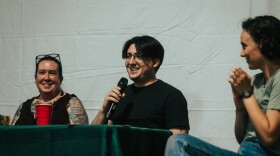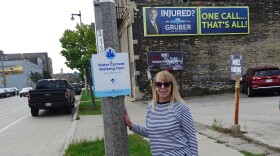UPDATE - The results are in. The winner of the Future City Competition National Finals is the City of Ville Suave created by the Academy for Science & Foreign Language in Huntsville, Alabama.
Now in its 24th year, the Future City Competition allows teams of 6th, 7th and 8th graders to design their city of the future. This year’s theme was “Waste Not, Want Not”.
The teams were charged with coming up with solutions to handle food, energy byproducts and the general clutter created by 21st century life. More than one hundred teams representing 20 Wisconsin schools participated.
Longfellow Middle School in Wauwatosa is WAY into the Future City Competition.
This year it boasted 21 teams. You could not help but be impressed with these kids, determined to come up with the winning waste control scheme.
8th graders Jenna, Carson and Levi create the City Ignis. “And our solution is plasma gasification which has to do with fire to eliminate trash,” Carson said.
The team devised an underground solution. “Because in the future, it’s going to be packed, so we might as well start going underwater so we have more space,” Jenna said.
Then there was George’s team – also 8th graders.
“This project uses only recycled materials, so everything you see here is not bought in stores – it’s totally recycled. Everything is from all of our houses, everything is recycled, nothing is not recycled,” George said.
Sixth graders Mick, Lance and Jack featured zipline transportation, and Jack’s waste solution – intensive recycling. “Some of the trash would not compost, so you would just have to recycle it to the most that you can, but if you can’t recycle it any more, you’ll just going to have to throw it out,” Jack said.
And who could resist The Green Thumbs. “Our city is Muir Nest named after a famous environmentalist, John Muir,” team member Sylvi said.
Their waste solution? Team member Claire said it includes “for municipal waste we have garbage shoots. There are three different shoots – there’s a recycling shoot, a composting shoot and a regular garbage shoot.”
Weeks later teams have been whittled down to 53. Most jam-packed the gym inside the Milwaukee School of Engineering’s Kern Center. Models of their cities fill the space.
None of the Longfellow teams I chatted with were among them, but seven others were.

Kelly Wesolowski guides me toward a small classroom where the Longfellow Villa Verde team is pitching their future city to five judges.
Wesolowski works with STEM Forward . It’s a nonprofit educational organization. The Future City Competition is just one the programs it coordinates to cultivate interest among young students.
The Longfellow team is using its “to-scale” model to illustrate its plan – this one features a futuristic version of the Eiffel Tower. A supplementary drawing shows the group’s waste solution – plasma gasification.
The judges follow up with questions including the favorite materials the team used to create its model.
I shouldn’t reveal this so early – but it will be hours before awards are announced. Villa Verde earned a special commendations for best use of recycled materials.
This intensive day of presentations, evaluation and judging requires a mountain of volunteers – more than 150 – and space is at a premium.

Kelly Wesolowski guides me to half dozen people entering early scores onto laptops BENEATH the bleachers.
“They have a model score sheet and a presentation score sheet. So those are the two scores from each judge that’s being entered,” Wesolowski said.
A MSOE freshman is volunteering for the first time at this event, and says she’s impressed.
“it’s cool because I like the idea of the children who are predicting the future cities and how they would be better than the cities now,” she said.

I stop by to chat with the creators of New Kolkata . They are Forest Park Middle School School 8th graders SiddarthaPunati and Shaun Wu.
They immediately leap into their presentation.
“The trash is sent to the processing factory where nanobots (robots) separate the organic materials from the inorganic materials,” Punati said.
“The recyclables and e-waste that have been broken down into materials that can be reused are put into 3D printers that will later print out the parts that are wanted or needed,” Wu added.
Punati and Wu’s model is mind-bogglingly complex, yet highly organized. I learn they two are good friends. They describe the experience of presenting to judges as …..

“Not too bad since we practiced a lot, but it was still pretty nerve-wracking. We messed up a little bit,” Wu said.
“I dropped some papers on the floor and I thought ‘I’m done’,” Punati said.
I’ll let you in on another secret – since you’ve been so patient – New Kolkata earned two special awards – one for project planning AND the other for the design and execution of its MODEL.
The massive sea of parents, students and teachers squeeze into the bleachers, as MSOE coordinator of student events Nick Seidler moved into the final, nail-biting portion of the program.
Seidler announces the four finalist teams. Whitman Middle School’s City of Gara, St. Alphonsus School’s Kai Aupuni team, Longfellow Middle School’s City of Seville team and Forest Park Middle School the City of Opala Lilo.

Can you imagine anything more nerve-wracking – the four finalist teams pitched their with six judges seemingly INCHES away and just beyond 300 “bleachered” observers
Then imagine being the 49 teams who had dreamed of making the finalist cut.
Golda Meir teacher Tina Gleason brought two teams to regionals. Between presentations she seizes the learning opportunity for her kids.
“So many of them now want to grow up and be engineers. My biggest thing is trying to get more girls involved and more diversity in the area. So it’s great just to see, I went from two years ago having six kids in the science club to over 40 this year, so it’s pretty amazing.
Finally the moment arrives.

The winning team is announced – St. Alphonsus’ Kai Aupuni team
The gymnasium explodes and the six 8th graders who make up the team glows with delight.
“I am very happy that my team got first place, because I’ve never gotten first place in any thing in my entire life. It’s just an amazing moment,” team member Zack Orton said.
How did they plan to prepare for the national competition?
“We’re probably going to practice on the airplane, in the hotel, everywhere,” said Colin Walsh.
At this moment St. Alphonsus and 34 other US teams, along with two from China, are in Washington, D.C. waiting to learn which future city comes out on top.
The honor comes with $7,500 for the school’s STEM program, plus a team trip to U.S. Space Camp in Huntsville, Alabama.
Judges in of the national Future City Competition will announce the winner later today.










